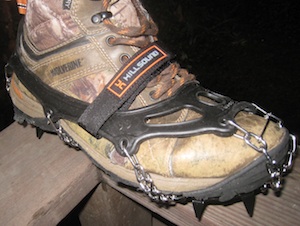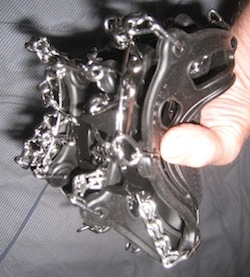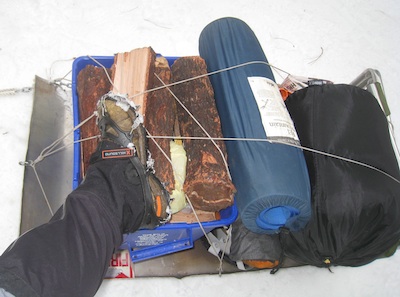

 |
 |
 |
Guest - Not logged in | |||
Reviews > Snow Gear > Traction Aids > Hillsound Trail Crampons 2016 > Test Report by joe schafferHillsound
Trail Crampon
Test Report by Joe Schaffer
REVIEWER
INFORMATION: INITIAL REPORT - December 8, 2016 FIELD REPORT - March 7, 2017 LONG TERM REPORT REPORT - May 9, 2017 NAME: Joe Schaffer EMAIL: never2muchstuff(at)yahoo(dot)com AGE: 69 GENDER: Male SHOE SIZE: US 9 HOME: Bay Area, California USA I enjoy California's central Sierras, camping every month with a goal to match my age in nights out each year. For comfort I lug tent, mattress, chair and such. Typical summer trips run 5-8 days; 40 lb (18 kg), about half food and water related; about 5 miles (8 km) per hiking day. I winter base camp most often at 6,000 to 7,000 ft (1,800 to 2,000 m); 2 to 3 nights; 50 lb (23 kg); a mile or so (1.6 km) on snowshoes. Sometimes I tug a sled over packed and/or icy terrain. Product: Trail Crampon  Manufacturer: Hillsound Equipment, Inc. Website: www.Hillsound.com TECHNICAL SPECIFICATIONS: (excerpted from mfr. website) – Spike Material: Heat-treated Carbon Steel – Chain Material: Stainless steel – Harness Material: Elastomer – Spike Height: 1.5cm / 2/3 in – Spike Number: 11 – Weight (pair): XS 14.6oz (414 gm) S 15.5oz (440 gm) M 16.3oz (462 gm) L 17.7oz (502 gm) XL 18.3oz (518 gm) Description: (excerpted from mfr. website) • Ergonomic plate system keeps spikes in place. • Intended for backpacking and winter and shoulder season hiking. • Secure footing reduces fatigue. • Spikes dig into ice and hard-pack snow. • Easy on/off elastomer harness retains pliability. • Rip and stick strap increases device stability. • Tempered double linked chains withstand torque and friction. • Lightweight and packable. MSRP: $59.99 US My Specs: (medium) Weight: 16 1/8 oz (459 gm) Received: December 6, 2016 My Description: These are very light, collapsible crampons packing up rather small compared to those I'm used to. They are intended for casual and not technical use. The crampons are essentially three pieces: 1) base plates with spikes; 2) chain connection of base plates to each other and to harness, and; 3) stretchy rubber harness to hold the device to footwear. The top gets more stability using a rip and stick strap from one side of the device over the foot to the other side.  The base plate is three pieces: 1) heel plate; 2) hinge plate, and; 3) front plate. The heel plate has four spikes. It connects via two chains up the back of the heel and two chains adjacent to each other reaching outward toward a center chain on each side that connects to the harness below the ankle on each side; and also two chains reaching inward to join the hinge plate at the rear center of the hinge plate. The hinge plate has two spikes. The hinge allows the forefoot to flex. The front plate has five spikes and connects to the harness via chain at each rear corner and adjacent chains in front reaching up the toe. A crosswire near the toe top helps keep chains in place and appears to absorb some stress that might otherwise transmit fully into the harness anchor holes. The harness has eight anchor holes for chain connection, all of which are thickened but without grommets. "Front" is indicated on the rubber, though not very easy to see. More likely I'll just need to note that the single plate goes under the heel. The harness is pliable and fits around the shoe a little like a big rubber band. Traction derives from the spikes, of course, and on softer surfaces from the steel plates and chain works as well.  Impressions: They look very grippy for the intended use on icy and packed snow surfaces. I like how light they are and how small they pack. Steel spikes make great sense to me, especially for hard surfaces. The points are not as sharp as I would expect for ice, though the intended use is not technical and if I try running in them (only if a rattlesnake is chasing me) I'll appreciate less aggressive puncture wounds to self and shoes. The hefty chains strike me as overkill, particularly since they connect directly through rubber. I'd think perhaps the link that goes through the harness could be big for less likelihood of tearing the mount, but the rest could be much smaller for an even lighter device that packs even smaller. I find a bit of a squeeze to get them on. They seem pretty secure once in place. I probably can slip them off while standing on one foot. Directions discourage one-foot stance and after I fall in the mud a time or two I'll probably pay attention. Field Conditions: Dec 30 - Jan 2: Gooseberry Trail, Stanislaus National Forest, CA. Started in packed, icy snow deteriorating in high temps; 30 lb (14 kg) backpack; 40 lb (18 kg) sled; 3 mi (5 km); 40-20 F (4 to -7 C). Feb 11-13: Blodgett Forest, El Dorado National Forest, CA. Snow too sparse and thin for crampons. Feb 28-Mar 3: Herring Creek, Stanislaus National Forest, CA. Soft, wet snow 6-18 in (15-45 cm) rotting in high temps; 25 lb (11 kg) backpack; 80 lb (36 kg) sled; 1 1/4 mi (2 k); 50-35 F (10-2 C).  Impressions: For the year-end trip holiday sledders and shoers packed the first 1/4 mi (0.4 km) down to 2 in (5 cm) of ice so slippery a lot of folks spent time on their fanny packs. Several people noted I was pulling a loaded sled uphill but not slipping--"Oh, you have crampons!" They worked perfectly for this condition where the packed snow was otherwise too slick for traction. As I got farther up the hill less traffic left the snow not as packed; and warm temperatures rotting the snow put a drag on the sled to the point I was pulling with all my might. But I never slipped. Even off trail for the last 100 yd (90 m) where the snow was about 4 in (10 cm) deep I still didn't slip. At this point the surface was crust over loose powder. The next day I made a second trip on very loose, gloppy snow. With no anti-bot plates I expected this condition might clog up the crampon, but did not happen. Snowshoes (which I did have) would have provided adequate traction in all conditions of this trip (not so hot for the icy start), but I found walking in the crampons much easier. The trip out was dry powder over ice and with little resistance from the sled I hiked as fast as I could walk with no traction issues at all--especially noteworthy on the steeper declines. A couple of times I caught a heel spike in a frozen clump and stumbled, but I never slipped or otherwise strained for traction. As hard as I dug in with these crampons, nothing broke and they stayed in place. I'd hoped Herring Creek Road would be snowmobile-packed, but the new snow was blazed only by three cross country skiers. Two nights of As the crampon was found at the location of one of the deeper drifts I think it is probable a posthole extraction stripped the crampon. I wasn't sure if gaiters would be best installed first, supposing the elastic band might seal the bottom even tighter against sloppy snow intrusion; or after the crampon. So I did the latter on the left foot and the former on the right. The supposed benefit proved unrealized as the gaiters on both feet performed equally well; and it was the over-gaiter crampon that came off. I now realize that of course gaiters should go over crampons as the covered heel strap would then be protected against scuffing off on the way out of a posthole and the stirrup would keep a stripped crampon dangling afoot instead of lost. The over-boot strap was seemingly in place as I'd put it, but it could have come loose and been re-stuck by the person who found it. I found no sign of damage to account for the loss. I can't, as directions stipulate, manage to get the crampons on while standing, with or without a backpack. I can remove them while standing. Now that I'm used to them they are easy to get on with warm fingers. In sub-freezing temps and blowing snow for my New Year's departure I struggled a little. One bit of frustration proved to be a spike caught in a chain link. It's hard to see the bottom of the shoe and I couldn't figure out why the chain was slack even though I was stretching the heel rubber as far as I dared (or maybe could). I find even gravity doesn't work right in those conditions. My greatest snow camping anxiety is spraining an ankle (since no ticks, poison oak or venomous reptiles). At Herring Creek I took a couple steps on pavement and quickly realized the width of the spike layout is somewhat less than the sole of my shoe. I was reminded of crossing the cart path in golf shoes and having to be on guard against ankle turns. Whenever possible I opt not to pay attention to what I'm doing. I seem to do OK at not snagging gaiters and I'd prefer a wider spike layout for this size. The over-boot strap seems like an afterthought, though it evidently fixes what happened without it. (I'd like to know what, as my what-can-I-take-off meter is ticking loudly over this strap.) The hook-and-loop likes to ice up while getting the crampons situated, and that makes the strap not want to stick. My fingernails really don't like scraping ice out of the hook material. Field Conditions: 4/20-23: Gooseberry Trail, Stanislaus National Forest, CA. Seriously slushy snow deteriorating in high temps; 30 lb (14 kg) backpack; 40 lb (18 kg) sled; 1 mi (1.6 km); 60-40 F (16 to 4 C). Impressions: Seems I do a lot of whining about conditions making the sled pulling hard, and this report does not deviate. I sat on my pack and got the crampons on without any difficulty, remembering to shake the teeth out of the chain loops. The road was clear to the snow, where the 'ramp' to the top of the snow was in the shade and fairly firm. The crampons worked tremendously well to make it up that steep ascent for ten feet (3 m) or so, even pulling the sled. Thereafter I post holed from 3 to 15 in (8 - 38 cm) every step. The sled came along OK on the slush but I got weary well before getting to camp. The sled's keel in the slop had little influence over gravity and I was constantly dragging the thing back out of tree wells. Anchored in post holes with spikes on my feet I could exert the force necessary to extract the sled without losing my footing. The snow was so loose that snowshoes would not bite. Given the difficulties of staying upright on snowshoes while trying to extract the sled on the downhill return route proved to me that the crampons worked better for that specific purpose, but overall in such loose snow I'd prefer slipping and sliding in snowshoes to sinking in crampons. Of course that isn't their purpose, and I regret not finding cold enough temperatures to perform a test in more suitable conditions. The snow was so wet that had it frozen, snowshoes probably would have broken and the crampons would have gotten a better test. My conclusion then, does not differ from the previous report. The crampons work great for ice and firmly packed snow. I didn't get to use them enough on ice to tell how quickly the points begin to wear and slip, but on those patches I did walk on, the devices performed beautifully. Post holing every step on the last trip I did not lose a crampon, having learned to put them on before gaiters. It seems I cannot accurately forecast conditions where the crampons would be ideal. They are so compact I'll happily have them on hand if not foot for my winter outings. Quick shots: a) light b) packable c) effective on hard surface d) not for soft snow e) narrower foot strike f) don't like the over-boot strap g) can come off Thank you Hillsound and BackpackGearTest.org for the opportunity to test these crampons. This concludes my test. Read more reviews of Hillsound gear Read more gear reviews by joe schaffer Reviews > Snow Gear > Traction Aids > Hillsound Trail Crampons 2016 > Test Report by joe schaffer | ||||